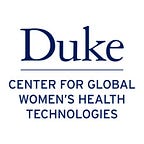Reflections from Curating the (In)visible Organ Art Exhibit
In 2020, our team at The Center for Global Women’s Health Technologies (GWHT) spent a lot of time and energy pausing for reflection, self-examination and listening as we seek to empower women. It’s been almost two years since GWHT hosted The (In)visible Organ Art Exhibit, and now our Calla Campaign team is sharing some reflections from their experience.
What did it feel like to be present on opening night for the exhibit, after almost a year of preparation?
Over 300 people came to opening night!
Such a vast assortment of people: artists from the Durham community, older Duke professors, partners and children… all convening in this sort of provocative exhibit space.
It was rewarding and almost unexpected to see men walk through the exhibit with their female partners and ask questions about their experience with reproductive health. Many seemed shocked that women have to go through a speculum-based exam.
People were genuinely shocked to learn all that goes into the female body.
How did the overall exhibit run?
Our director, Dr. Nimmi Ramanujam, and Dr. Hogan took a risk in creating an art exhibit that covers reproductive health and women’s health so provocatively.
The entire lab came together in the month leading up to the exhibit to get everything done. Lab members took shifts and some spent long nights (until 1 AM) working with the curation team to make sure everything was ready for opening night.
What was difficult?
This exhibit involved integrating two sides of academia: STEM and humanities. As a project of this scale was new to the majority of members on our team, we vastly underestimated how much work goes into curating one space.
Like anything that happens for the first time, we had a lot to learn even after the exhibit was completed.
Working collaboratively between a large institution like Duke and community-based artists and activists was no easy task. Effective communication and navigating institutional logistics were challenges that the team had to overcome in real time.
What did curating the art exhibit help GWHT learn?
Through the preparation and execution of this massive endeavor, several institutional challenges arose in working with the art and activist community. Although Duke is a global leader in community engagement at the higher education level, the intensively collaborative nature of this exhibit laid bare challenges that such institutions still need to overcome in effectively and meaningfully engaging the community, such as payment timeline.
Due to the challenges we faced, our team has decided to postpone the curation of another exhibit until we are able to address those challenges.
Perhaps our next art event will be more along the lines of workshops that could be open to the community, rather than a large scale exhibit.
What is next for (In)visible Organ?
On January 14th we are premiering a documentary! We hope you can join us!
The documentary investigates how the design of technology impacts healthcare, especially when concerning an intimate part of the female body, by following GWHT’s Callascope.
RSVP today at: https://lnkd.in/d5e6FiD
